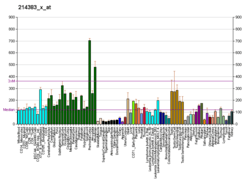Kelch domain-containing protein 3 is a protein that in humans is encoded by the KLHDC3 gene.[5][6]
The protein encoded by this gene contains six repeated kelch motifs that are structurally similar to recombination activating gene 2 (RAG2), a protein involved in the activation of the V(D)J recombination. This gene is found to express specifically in testis. Its expression in pachytene spermatocytes is localized to cytoplasm and meiotic chromatin, which suggests that this gene may be involved in meiotic recombination.[6]
Further reading
- Ewing RM, Chu P, Elisma F, et al. (2007). "Large-scale mapping of human protein-protein interactions by mass spectrometry". Mol. Syst. Biol. 3 (1): 89. doi:10.1038/msb4100134. PMC 1847948. PMID 17353931.
- Gerhard DS, Wagner L, Feingold EA, et al. (2004). "The status, quality, and expansion of the NIH full-length cDNA project: the Mammalian Gene Collection (MGC)". Genome Res. 14 (10B): 2121–7. doi:10.1101/gr.2596504. PMC 528928. PMID 15489334.
- Ota T, Suzuki Y, Nishikawa T, et al. (2004). "Complete sequencing and characterization of 21,243 full-length human cDNAs". Nat. Genet. 36 (1): 40–5. doi:10.1038/ng1285. PMID 14702039.
- Mungall AJ, Palmer SA, Sims SK, et al. (2003). "The DNA sequence and analysis of human chromosome 6". Nature. 425 (6960): 805–11. doi:10.1038/nature02055. PMID 14574404.
- Ohinata Y, Sutou S, Mitsui Y (2003). "Peas-Mea1-Ppp2r5d overlapping gene complex: a transposon mediated-gene formation in mammals". DNA Res. 10 (2): 79–84. doi:10.1093/dnares/10.2.79. PMID 12755172.
- Ohinata Y, Sutou S, Mitsui Y (2003). "A novel testis-specific RAG2-like protein, Peas: its expression in pachytene spermatocyte cytoplasm and meiotic chromatin". FEBS Lett. 537 (1–3): 1–5. doi:10.1016/S0014-5793(03)00036-X. PMID 12606021.
- Hermey G, Keat SJ, Madsen P, et al. (2003). "Characterization of sorCS1, an alternatively spliced receptor with completely different cytoplasmic domains that mediate different trafficking in cells". J. Biol. Chem. 278 (9): 7390–6. doi:10.1074/jbc.M210851200. PMID 12482870.
- Strausberg RL, Feingold EA, Grouse LH, et al. (2003). "Generation and initial analysis of more than 15,000 full-length human and mouse cDNA sequences". Proc. Natl. Acad. Sci. U.S.A. 99 (26): 16899–903. doi:10.1073/pnas.242603899. PMC 139241. PMID 12477932.





